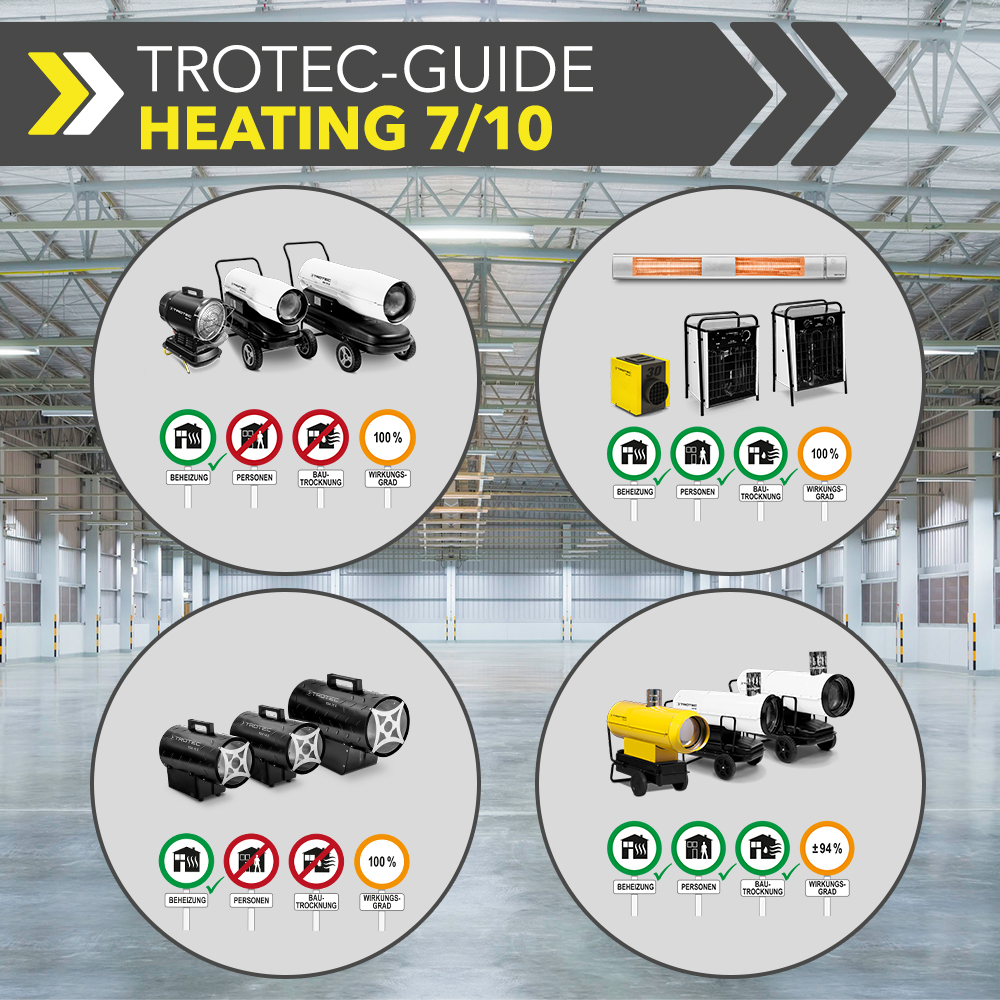“Take out your exercise books: now we’re going to do a test!” Phew – isn’t it great to be reading a modern guidebook geared to sustainable learning through repetition? And one which instead of attracting unwanted attention with exam questions, neatly and systematically summarizes the above info for particularly inquisitive minds? The direct oil heater without chimney and the infrared oil heater, the gas heater and the indirect oil heater with chimney plus the electric heaters and the infrared radiant heaters. Now as a quick comparison!
Direct oil heaters without chimney and infrared oil heaters from 20 kW to 100 kW
Direct oil heaters and infrared oil heaters are ideally suited for use in well ventilated indoor spaces, whereby the total generated heat is actually available as 100% output.
Important to know
- Besides heat, direct oil heaters (without chimney) and infrared oil heaters also release combustion exhaust gases directly into the room. They are therefore unsuitable for closed rooms without good ventilation (oxygen supply) in case persons or animals are inside.
- Moreover, they also generate approx. 1.6 kg of water vapour per litre of fuel during combustion and are thus not suitable for drying the building structure. When using direct oil heaters for accelerating construction drying, the building would, in the worst case, thus be more humid than it was before!
- Direct oil heaters and infrared oil heaters must not be used in rooms subject to potential fire hazards and that store flammable substances.
Direct gas heaters from 10 kW to 30 kW
Gas heaters are recommended for use in well-ventilated indoor spaces and in covered outdoor areas, where the total heat developed is in fact actually available as 100% output.
Important to know
- Besides providing heat, gas fan heaters release combustion exhaust gases directly into the room as well. They are therefore unsuitable for closed rooms without good ventilation in case persons or animals are inside.
- What’s more, during combustion approx. 1.6 kg of water vapour is produced per litre of fuel. Direct gas heating devices are therefore not suitable for construction drying. When using gas fan heaters for construction drying, the building would, in the worst case, thus be more humid than it was before!
- Gas heaters must not be use in rooms subject to potential fire hazards, e.g. by storing flammable substances.
Indirect oil heaters with chimney from 20 kW to 375 kW
In order to generate clean and dry heat without allowing combustion products or water vapour to be released into the room air at the same time, indirect heaters (with chimney) are required.
Important to know
- When it comes to indirect oil heaters, the air to be heated is completely disconnected from the combustion chamber and can be directed into the respective rooms either directly or using hoses.
- The combustion exhaust gases, in contrast, are discharged into the open by the chimney. As a result, the heat output efficiency is not 100%, as is the case with direct oil heaters, but only approx. 92 to 95%, since one part of the hot air is lost through the chimney with the exhaust gases.
- Indirect heaters are therefore ideal for rooms with persons or animals inside and where only limited ventilation is possible.
Electric heaters and infrared radiant heaters from 2 kW to 120 kW
Electric heaters and infrared radiant heaters are recommended as a safe, fast and convenient heating solution. All you need is a corresponding power connection and no additional handling effort is involved, as in the case of oil or gas heaters. They provide, just like direct oil or gas fan heaters, 100% heat output efficiency.
Important to know
- When heating, neither combustion exhaust gases nor water vapour is generated and no oxygen is consumed. Therefore, any use in rooms with people or animals inside is not a problem.
- Electric heaters are frequently used in construction projects, in marquees, warehouses and workshops, on ships, in switching stations, cattle sheds, garages and in temporary accommodations. Moreover, electric heat fans are suitable for supporting dehumidifiers during construction drying, as no condensate (water vapour) is released. When it comes to infrared heaters, IR heating panels are recommended for construction drying.
- Electric heaters generally have, depending on the electricity rate, higher operating costs per kW heat output than oil or gas operated heating devices
Trotec brand quality – oil heaters, electric heaters and gas heaters in all performance classes from 2 kW to 375 kW
- Click here to go to an overview of the professional heaters from Trotec
- Or you can call our team of experts for a purchase at +49 2452 962-400 or for rent at +49 2452 962-160 or use our contact form. We provide advice when it comes to choosing one and answer your questions regarding all heating related topics.
Overview of the Trotec guide ‘Heating’
1/10 Direct oil heaters – can be used in well-ventilated indoor spaces and covered outdoor areas
2/10 Direct infrared oil heaters – precisely directed infrared heat radiation
3/10 Chimney oil heaters (indirect oil heaters) – exhaust-free heat for indoor use
4/10 Gas fan heaters – affordable heat for well-ventilated indoor spaces
5/10 Electrical hot air fans – convenient, safe, clean and fast heat
6/10 Infrared radiant heaters – heat right where it is needed with no warm-up time
7/10 Quick comparison – which heating type for which intended purpose?
8/10 HEATBOX – enjoy energy savings of up to 70 % when heating tents and halls
9/10 Accessories for heaters outside the home – solutions from Trotec
10/10 Calculating the required heat output – the online heat output calculator from Trotec


